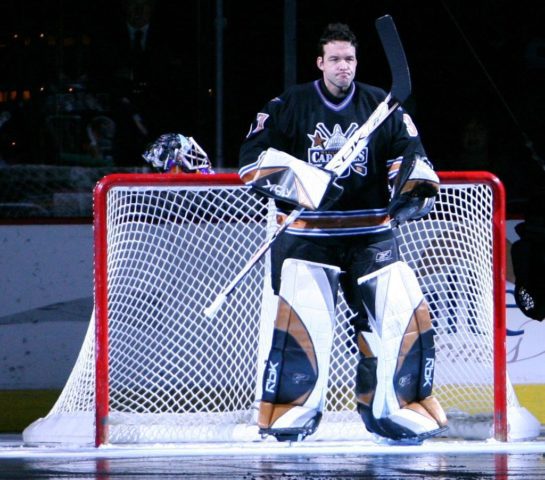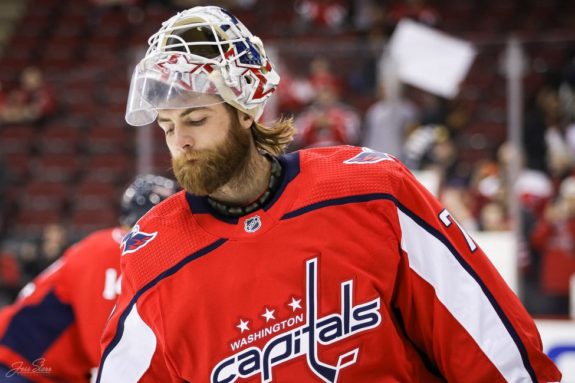Not many NHL stories start in South Africa. Olaf Kölzig‘s did. Born in Johannesburg to German parents, he didn’t stick around long—his family eventually landed in Union Bay, British Columbia, where the air was colder and the ponds were actually frozen.
Related: What’s Wrong With Oilers Goalie Stuart Skinner? A Closer Look
Eventually, Kolzig became an elite goalie who played 16 seasons with the Washington Capitals. Kölzig never won the Stanley Cup, although he came closest in the 1997–98 season when the Capitals reached their first-ever Stanley Cup Final but lost to the Detroit Red Wings. He did win the Vezina Trophy in 2000 as the NHL’s best goaltender.
The Kolzigs Ran the Union Bay Market, a Local Community Hub
Kolzig grew up in Canada’s far west on Vancouver Island. His family became a well-known part of the Union Bay community on the Island by running the Union Bay Market, which was a local landmark. Owned by his parents, Axel and Renate, the market wasn’t just a place to shop—it was the hub of this tiny ocean-side community and now part of the area’s pride.

Standing proudly atop the building was a 250-pound cedar replica of the Stanley Cup, hand-carved by local artist Brian Lindstrom, a tribute to Olaf’s hockey dreams. Over the years, the “Canuck Cup,” as fans affectionately called it, was restored and displayed in the market’s courtyard, symbolizing the family’s support and the strong ties between Olaf’s early life and the community that helped shape him.
Related: Filip Forsberg Trade Revisited
That’s where Kolzig found hockey. Or maybe it found him. He worked his way up through the Western Hockey League (WHL) with the New Westminster Bruins and later the Tri-City Americans, where he wasn’t just a good prospect—he was a battler. A guy who didn’t flinch when the puck dropped.
Kölzig’s Road to the 1997–98 Stanley Cup Final and the Vezina Trophy
Kölzig honed his skills in the WHL, where he stood out for his exceptional work ethic, resilience, and mental toughness. Those traits would carry him into the professional ranks, setting him apart from other young goaltenders.
The Capitals picked Kölzig 19th overall in the 1989 NHL Draft. He didn’t jump straight into the spotlight. He put in the work in the minors, waiting for his shot. Nothing came easy—he earned everything with grit and patience. No shortcuts. No guarantees.
Then came 1997–98. That’s when everything changed. Kölzig posted 33 wins, a 2.20 goals-against average (GAA), and a .920 save percentage (SV%) —and just like that, Washington was in its first-ever Stanley Cup Final. The Caps didn’t win it (Detroit took the Cup), but a statement was made: Kölzig was the Capitals’ guy.
Fans still talk about the way he’d slam his blocker against the post after a big stop, or the way he’d pump his fist after an overtime win. Those weren’t just celebrations—they were moments that stuck. The kind you remember years later, right down to the sound.
Related: How Did Capitals Prospects Perform at the 2025 World Junior Summer Showcase?
By 1999–2000, Kölzig was at the top of his game: 41 wins, a 2.24 GAA, and a .917 SV%. That season, as noted earlier, he won the Vezina Trophy as the NHL’s best goalie. But if you watched him play, you know he wasn’t out there trying to be a star. He wasn’t flashy. He didn’t chase the spotlight. He just showed up and delivered—night after night.
Off the Ice: Humanitarian Work and Foundations
Kölzig’s legacy isn’t just about what he did in the crease. After his son Carson was diagnosed with autism, he co-founded Athletes Against Autism and launched the Carson Kölzig Foundation for Youth Autism. In 2006, he received the King Clancy Memorial Trophy for his leadership and humanitarian work.
Kölzig didn’t just make saves. He made a difference. In 16 seasons with Washington, he set just about every goaltending record you can think of: 711 games, 301 wins, 35 shutouts—an impressive résumé. But for Caps fans, it wasn’t just about the numbers. It was about knowing Olie was in the net. Win or lose, you trusted him to give everything he had.
Leadership Style and Locker Room Impact
Kölzig didn’t need to shout in the locker room. He led with presence. He led by showing up, playing hard, and having his teammates’ backs. Through playoff pushes and tough rebuilds, he was the one constant. A steady hand in the net when everything else felt uncertain.

His number hasn’t been officially retired—but no one’s worn it since. And honestly? They don’t need to hang a banner. The silence around #37 says everything. After retiring in 2009, Kölzig came back to the organization, this time behind the scenes (as a goalie coach, in player development) his fingerprints are all over the next generation. He’s still helping young netminders carry that Caps crest with pride. With Braden Holtby, Kolzig is one of the top two goalies the Capitals have produced.
Olaf Kölzig’s Capitals Legacy
Kölzig, also known as Godzilla, wasn’t just the guy in the crease. He was the soul of the team before the banners went up. He gave the Capitals a true identity—a mix of toughness, humility, and loyalty that fans could rally around.
Related: The Home of Champions: Trail, B.C.’s Forgotten Goaltending Legends
His name might not be the first one that comes to mind for casual fans. But to the ones who were there—who watched the saves, felt the heartbreaks, and stood by during the rebuilds—he’ll always be the goalie. And in Washington, that means everything.
Author’s Note: The idea for this post on Olaf Kölzig started recently when I was speaking with a retired high-level hockey referee who lives nearby. He told me that Kolzig grew up only about half an hour from where I live on Vancouver Island. Who knew? It felt just too close to pass up, which is why we decided to write about him.
[Note: I’d like to thank Brent Bradford (PhD) for his help co-authoring this post. His profile can be found at www.linkedin.com/in/brent-bradford-phd-3a10022a9]
